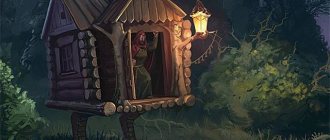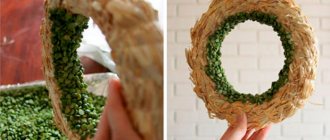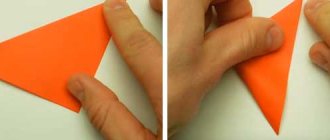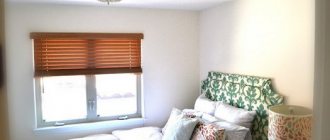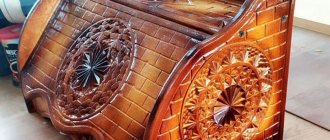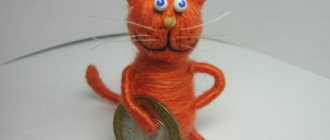A DIY shelving unit is not only simple, but also economical. If you have never made something with your own hands before, then a whatnot is the first step for a novice craftsman.
What is a bookcase? This is a furniture option that consists of shelves combined into a common structure. The shelf can be used for flowers, shoes, personal care products or tools.
There are no restrictions on the use of shelves, except for weighing ones. You should not load the bookcase with too much weight, because it is not a rack.
A bookcase, as you know, is a cabinet without walls.
Long gone are the days when the whatnot was the “highlight” of the living room and the hostesses of secular salons vying with each other to see whose was cooler.
The benefits of making it yourself
Do you know what the advantages of any “hand-made” product are?
- Savings in its purest form. Often, when buying a finished item, you have to overpay for the brand name, for low-quality material purchased in bulk, and for the work of the craftsman.
- Meets all requirements. You make a bookcase according to certain technical characteristics: width, height, number of shelves, material, color. Of course, stores offer a huge variety of options for any furniture. The bookcases were no exception. But most often, products produced on a machine are measured in whole units. You can make an interior item that is ideal in size and style.
You can name other advantages to making a bookcase with your own hands, but all the main ones are highlighted.
It is also shelves height from the floor, sometimes on wheels, or a rack for a relatively small operational load, not attached to the floor, walls or ceiling.
Nowadays, most of the shelves in everyday life are used to place indoor plants.
Folding table with wall mounting
At first, mounting to the wall does not seem like a very rational solution. But this is only at first glance. In fact, if you manage your space wisely, you can easily use never-used square meters.
Where? Above the central heating radiator. Great solution because:
There are quite a lot of advantages of this design, but presenting a drawing is completely useless, since everyone’s conditions are different.
The main design elements of this folding table are the wall mounting system.
This can be either a metal corner sewn to a concrete wall with dowels, or a wooden beam as a base. It is quite simple to assemble the structure based on furniture fittings; we have already found several options for such a table and presented them in the form of pictures. Good decision, isn't it?
Deciding on design and construction
The design of the bookcase depends entirely on your desires and capabilities. If we are talking about a bookcase as a decorative element, then you can choose an interesting material: rattan or glass, beech or forged metal.
A multifunctional piece of cabinet furniture that can effectively zone a room and be aesthetically significant in the interior.
Here the openwork of the whatnot works for functionality: using the whatnot, plants can be placed on a minimal floor area so that they do not shade each other and it is convenient for the owner to care for them.
Naturally, only a true master who knows how to work with this or that material and has the necessary tools can do this with his own hands.
You can make a bookcase from any more or less durable and workable material, but novice furniture makers should not get carried away with their variety.
For the same purpose, special shelves for flowers are built, but they are, as a rule, stationary, attached to some kind of base, and the shelf is adjustable.
Speaking of practical applications, making a bookcase with your own hands is quite simple. The design consists of two vertical bases and horizontal shelves between them. There are an incredible variety of mounting options and they depend on the material of manufacture.
- The easiest way is to screw the shelves to the base from the outside. This assembly method is relevant for wooden shelves. If you think that it will not be beautiful, then we can reassure you, there are plugs for self-tapping screws in different colors.
- Each shelf has holes in the corners; posts are inserted into these holes to separate the shelves from each other. Most often, this design is offered for plastic shelves for bathtubs or shoes. But glass shelves can also be organized in a similar way. Dividing posts can be chrome plated. Although metal can also be assembled into a bookcase in a similar way.
- The variety of fittings allows you to choose fastening elements hidden in the body of the product.
Shelves assembled using hidden mortise carpentry joints are rarely made independently, and are expensive to sell.
Even today, a shelf can become a key element of interior design.
These are the main examples of whatnot design. You can improvise or use decor. Thus, forged elements can give the simplest and most inexpensive wooden product not only charm, but also luxury.
The most durable is a wooden shelf assembled with an overlay.
Well-made rustic furniture looks amazing and fits into almost any interior, down to the loft.
Rack on wheels
A small shelving unit on wheels is more suitable for those who do not have the ability to mount the storage system to the wall or who need a mobile version of the device. This product has a certain discreet elegance that is typical of simple loft-style models.
To make the shelving strong and inexpensive, we will use pine wood. There are no difficulties in working with this material, and it is also quite strong and durable.
Prepare everything you need
- 15 2x6 (5x15 cm) pine boards, 8 feet (243.8 cm) long;
- 4 2x4 (5x10 cm) pine boards, 8 feet (243.8 cm) long;
- 10 pieces 1x2 (2.5x5 cm) 6 feet (182.8 cm) long;
- 2 boards 1x2 (2.5x5 cm) 8 feet (243.8 cm) long;
- 1 pine board 2x2 (5x5 cm);
- 2-8 foot (60.9-243.8 cm) boards;
- dowels;
- 4 metal rods 67.25 inches (170.8);
- 4 metal corner brackets;
- 4 metal furniture wheels ranging in size from 4 inches (10 cm) to 6 (15.2 cm);
- 2 inch (5 cm) screws;
- sandpaper;
- wood glue,
- putty;
- primer;
- paint or varnish for finishing.
In addition, you will need to use a pocket hole tool, drill, level, tape measure, square, pencil, circular saw, grinder.
You can familiarize yourself with the dimensions of the rack and the location of components by looking at the figure below.
Cut out the details of the rack according to the list:
- 15 shelf blanks 2x6 (5x15.2 cm) 64.75″ (164.5 cm) long;
- 10 long shelf end pieces 1x2 (2.5x5 cm) 66.25″ (168.3 cm) long;
- 10 side shelf pieces 1x2 (2.5x5 cm) 16.5″ (41.9 cm) long;
- 10 side rail blanks 2x2 (5x5 cm) 11″ (27.9 cm) long;
- 4 parts – side vertical posts 2x4 (5x10 cm) 75.5″ (191.8 cm) long;
- 4 steel rods, 67.25″ (170.8 cm) long.
Work order
Start creating a shelving unit by assembling five identical shelves. Each shelf will consist of 7 parts.
- Prepare pocket holes in 2x6 (5x15.2 cm) strips 64.75″ (164.5 cm) long, indicated in red in the picture. Assemble three planks together using screws and wood glue, applying it to the joints.
When strengthening the joints of structural parts with wood glue, excess glue protruding in the seams should be immediately wiped off with a rag or a wet sponge. This way the finished product will turn out neat, and the absorbed glue will not interfere with evenly covering the wood with a protective or finishing agent.
- Next, install 1x2 (2.5x5 cm) strips 16.5″ (41.9 cm) long on the short sides of the future shelves. They are highlighted in blue in the figure. Use screws and glue.
- Similarly, attach long 1x2 (2.5x5 cm) end strips to the shelves, 66.25″ (168.3 cm) long, highlighted with yellow shading.
- Assemble the side posts of the shelving unit. To do this, use 2x4 (5x10 cm) strips 75.5″ (191.8 cm) long, indicated in green in the picture. First, refer to the schematic diagram and mark the attachment points for the crossbars.
- Prepare pocket holes at the ends of short 2x2 (5x5cm) strips that are 11″ (27.9cm) long. Make connections in the designated areas using screws and glue.
- Choose the location of the metal limiting rod that is convenient for you, prepare through holes for it corresponding to its diameter on one (rear) vertical strip of each of the two “stairs”. Be careful not to drill too close to the edge of the plank, otherwise the wood may crumble.
- Assemble the shelving unit, starting with the bottom and top shelves. Then attach the middle ones one by one. Use screws and glue.
- Place the steel rods in place. Secure their position with suitable nuts.
- Fill the recesses where the screws are attached with putty. Leave the rack until the composition is completely dry.
- Using sandpaper or a sander, remove any remaining special product and, if any, large imperfections on the surface of the wood. The rack should not have perfectly smooth surfaces, but given that the structure will be movable, it should be safe to use.
- After removing the dust, apply a protective compound (for example, stain) to the wood. Leave to dry.
- If you want, you can coat the rack with wood varnish. This finishing treatment is not necessary, but it will protect the wood from aggressive external influences (moisture, temperature changes, etc.). Leave for a while so that the varnish can dry.
- Install metal corner caps on the upper and lower corners of the product using a drill and screws.
- Place the shelving carefully. Screw four metal wheels to the bottom (in the corners) with screws.
Our guide allowed you to assemble with your own hands not just a rack on which to conveniently store tools, but a universal, functional piece of furniture. If desired and some amendments are made, it can serve in an office, living room, kitchen, etc.
Necessary materials
How to make a bookcase with your own hands is clear. You should decide on the materials needed in this matter.
- Assembling a plastic shelf bought in a store is as easy as shelling pears; just assemble the “construction set” according to the instructions and use it with pleasure.
- When working with wood, in addition to the main material, you will need fastening elements (screws, nails, corners). Let us note that wood is a material subject to mechanical damage: the wood dries out, the wood rots, and insects eat it. To protect your piece of art, you should coat it with varnish or wax. To add color, you can use paint or tints.
- If we are talking about metal, then you should study the issue in more detail. In an apartment, an iron shelf can be used quite rarely. There is stainless steel in the kitchen, stainless steel in the bathroom, stainless steel in the hallway. Ferrous metal is only suitable for a tool.
- Glass can be a material for shelves, both individually and in the overall design.
It may have four or more legs with shelves between them. As a rule, it does not have back or side walls.
Those who want to learn how to make rustic things are faced, first of all, with two tasks: aging the wood while simultaneously increasing its decorative qualities and surface strength, and also, as regards rack-mounted shelves, adjusting the junction of branch cuts for the racks.
Working with all these materials requires certain skills and tools. What can we say about more complex materials?
A type of shelving made from overlay planks is household frameless (with sidewalls made of one board each) shelving-ladders.
Use decorative forging, ropes or leather inserts
Models
Furniture manufacturers offer a wide range of tables, which differ in tabletop shapes, design types, sizes, fastening features, the presence or absence of certain components (for example, legs), and materials. In addition, the models differ in design: color and texture of the countertop surface. There are expensive options made from natural materials (solid wood or glass) and more budget ones that imitate natural stone or valuable wood species (most often plastic or veneered surfaces). Some tables are complemented by decorative inserts from other materials, carvings, inlays, and furniture fittings.
Forms
Folding tables are available with four tabletop shapes:
- Square. Ideal for a small family of three.
- Rectangular. The tabletop of the model is more spacious and can be used even for modest feasts with guests. Such folding tables are fixed both across the wall and along it.
- Semicircular. Tabletops of this shape have a small capacity and are therefore rarely used. Although the option looks original and suits classic interiors and Art Nouveau furnishings.
- Round and oval. The rarest variations. It looks stylish and unusual, but is rarely used due to its small capacity. The option is optimal as a dressing table in the bedroom or a workspace for one person.
In rooms with complex configurations, tables of non-standard shapes can be used. They are usually made to order.
Construction type
By type of design, folding tables are classified into the following types:
- Transformers. They can be wall-mounted or wall-mounted. The main distinguishing feature of the design is its versatility. If desired, it can turn into a compact workplace, replacing a desk, or into a full-fledged dining area.
- Folding table. A simplified version of the transformer, which does not have additional features. When folded, the tabletop assumes a vertical position, but at the same time a static “piece” remains against the wall, so the model is not completely assembled. Can be wall-mounted or wall-mounted. A striking example of the second option is a book-table. It became the first prototype of a folding table, which was familiar to every person from Soviet childhood. It was a tall “coffin” with two tabletops on either side of a narrow board in the middle. The “wings” are usually in a lowered state. When you need to set the table for a holiday, they are raised and fixed in a horizontal position. This piece of furniture really saved large feasts, since its area when unfolded increased several times. At a time when the model did not fold out, its narrow static tabletop was used as a shelf. When assembled, the “book” takes up very little space, but is still inferior to folding tables built into the wall.
- Folding. The simplest and most popular model. The table can be mounted on any vertical surface, be it a wall or the front of a cabinet. In addition to the tabletop, such models are usually equipped with a number of shelves. If the table is located in the kitchen, then they are filled with dishes. When the model is used for work, books and writing materials are stored in the shelves. The design is designed for heavy loads. As a rule, it has no legs, so the fastening to the wall must be reliable so that the table does not collapse at the feet of the owners. The tabletop does not rise, but folds down. This is its main difference from the folding model.
- Mobile folding table. The model is in many ways similar to the previous one, but differs in mobility. The tabletop moves along a guide mounted into the wall. This folding table is convenient for small apartments with a non-standard layout.
- Hanging. Tables without legs. They are compact, as they are not designed for heavy loads.
- Folding bar counter. It features a narrow, elongated tabletop. Ideal for small kitchens. Fixed high, like a classic bar counter. Often complemented by the same high chairs.
Although transformers and folding tables belong to the folding category, in classic models the tabletops are lowered during folding, and not raised, as happens in the two cases described above.
Required Tools
what tools you will need to assemble a bookcase with your own hands ; it depends directly on the material.
When working with plastic:
- hands and intelligence.
If the material is wood:
- screwdriver or drill;
- hammer;
- sandpaper;
- brushes
If the shelf is iron:
- welding machine;
- Bulgarian;
- sandpaper.
Glass shelf:
- glass cutter;
- sandpaper;
- grinder (for cutting jumper pipes).
For the strength of the attached ladder shelf, its shelves must be box-shaped without extension.
Some knowledge about measures to ensure it is useful not only for designing furniture.
It’s not a fact that all the tools will be useful to you, but you shouldn’t start work without having basic technical tools at hand.
Rack-mounted shelves have the highest ratio of strength to the amount of material required for manufacturing.
The same openwork will allow you to express yourself in an object and get a unique thing with minimal consumption of material.
Diagonal option
This type of wine placement is practiced everywhere. Any person can do it. To do this, it is enough to have some kind of wooden box or knock it down yourself.
When making it yourself you need:
- Cut four identical pieces of wood that are equal in width to the height of the bottle (or slightly less). Ideally, when assembling them, you should get a square.
- Measure the diagonals and cut 2 more pieces according to the resulting dimensions. These are the main elements.
- In the middle of each of them (up to half) a groove is cut with a width equal to the thickness of the wood.
- Insert elements into each other. You should get a design that resembles the letter “X” or a cross. It is placed in a square and secured with self-tapping screws. The bottles are placed in the resulting compartments.
Manufacturing process: step-by-step instructions
It’s quite difficult to say how to make a bookcase if you don’t know what material and design option you will choose.
The process looks like this:
- choice of material;
- design choice;
- measuring the height and width of the product;
- production of horizontal shelves (size should take into account vertical racks
- production of vertical support);
- assembly;
- decoration.
The plan is quite general, but the design of the bookcase is not a standard of skill, but only the first stage.
Rack-mounted shelves are assembled using glue and pins that pass through the shelves and go into deep holes (sockets) along the axis of the racks.
You can make a bookcase from any more or less durable and workable material, but novice furniture makers should not get carried away with their variety.
Table transformer
The main advantage of transforming tables is that they are most convenient to pull out and push apart. It is often used in the kitchen, instantly turning the work area into a mobile dining room. Once the meal is over, the table can be transformed into a more compact version or even “disguised” among the kitchen attributes.
For a small kitchen, miniature tables are provided that lack a supporting leg or are equipped with only one such part. It is advisable not to overload such structures.
A transforming table will come in handy in a student’s room, who can study in the reading area at any convenient time. Then, having folded the folding transformer and freed up space, start playing games and other active entertainment.
The final stage is decoration
If you are interested in the question of how to make a bookcase with your own hands, the answer is in front of you. But how to decorate a ready-made bookcase? The easiest way is painting. Choose a color that suits you and paint your counter shelf in wood or metal. Use decorative forging, ropes or leather inserts. Wood is combined with metal, textiles, and plants.
Functionally, the shelves of rack-mount shelves can be of any required height and extended to almost the entire width.
A forged or cast bookcase can be a work of art, but is functionally very reliable and durable.
Good luck!
Rack-mounted bookcases have a rather serious drawback from the point of view of an amateur: in order for the bookcase to turn out beautiful and original, you need turned wooden parts.
What are they made from?
As already mentioned, garage shelving is made of wood and metal. Wooden ones are lighter in weight, it is easier to work with wood, but they do not withstand such heavy loads. Metal ones are heavier (many times heavier), but you can lay an elephant on them.
There is also the issue of price. Rolled metal is not cheap at all these days. If you buy everything at the market or in a store, one rack (including consumables) will cost you almost the same amount as a finished one. The only real way to save money is to buy metal at a metal warehouse in whole lengths (there are 6 m and 12 m), and then cut it into pieces of the required length. The cutting can be done directly at the base; you will have to pay additionally for the services, but the amounts are quite small. In this case, you will be able to reduce costs by about 20-30%.
One of the layout options
Lumber costs less than metal. But don’t think that the costs will be small: you will have to buy graded wood without knots, and this is the “elite” or “premium” class with a corresponding price tag. So it won't be very cheap.
Made of wood
Operating conditions in the garage are far from the best - high humidity, frost, alternating freezing/freezing, and sometimes heat. Not very good for wood. Therefore, all material must be treated with antibacterial and protective compounds before work. Use wood products for exterior use, as conditions in an unheated garage are more similar. You can choose a product that simultaneously tints the surface being treated and your product does not need to be painted. After processing, the materials are dried and only then work begins.
How to connect bars
When connecting parts of a wooden rack, you can use standard methods for carpenters - quarter-foot or half-foot. If this is difficult for you, you can also butt nail and use metal angles and/or overlay plates to reinforce the joints.
Another point: it is better to connect with nails, not with screws. The result is more stable and fewer connections become loose. If you choose the option with reinforcement with plates, they can be mounted with self-tapping screws.
Wooden garage rack
Now in terms of size: for racks they usually use 50*50 mm timber, for crossbars you can use the same timber or a little thinner - 50*30 mm. Flooring is made from:
- boards with a thickness of at least 21 mm;
- moisture-resistant plywood with a thickness of 10 mm;
- laminated chipboard;
- OSB.
The cheapest are boards and plywood. Laminated chipboard is much more expensive, but it does not need to be painted, which is a good plus. In order not to spend a lot, you can take the first and last sheets in a pack at the bases - they are scratched and are much cheaper.
Wooden shelving for the garage - drawing with dimensions
Another point: chipboard shelves have an open side cut. If it is not treated, as humidity increases, the chips will swell and the shelf will begin to warp. To prevent this from happening, coat the edges with silicone. With this treatment, nothing will happen to the chipboard.
Metal
If you decide to make metal shelving for the garage, the choice of materials is wider - there are two options for rolled metal, plus standard solutions for warehouses (perforated corners). You can also use metal parts intended for other purposes - for example, steel cable racks or cable channels that are used in communications are suitable.
Cable channels and shelves - convenient and not very expensive
So, what is the frame of a metal garage shelving made from:
- From a metal corner with a metal thickness of 3-4 mm. The width of the corner shelf is 25-45 cm, depending on the planned loads. Durable, but metal-intensive material, weighs a lot, and is expensive.
- Profile pipe (rectangular in cross-section). With less metal consumption (less wall thickness), compared to a metal corner, it has better elasticity characteristics (more difficult to bend), and is more resistant to torsion. Approximate dimensions for racks are 50*50 mm or 40*40 mm, for crossbars 50*25 mm or 40*25 mm, respectively.
- The racks are made from corrugated pipe, and the crossbars are made from angle iron. The thickness of the metal is 2-3 mm, the width of the shelf is 25 mm or more. Unfold the corner so that the laid flooring looks like it is in a “nest”.
Take a closer look at how the corners are located.
The flooring on the shelves is made from the same materials as for a wooden rack (board, plywood, OSB, chipboard), only sometimes non-standard options are added, which are used sharply with a wooden frame due to the high mass - sheet metal.
The board remains optimal for most regions - a reliable, not very expensive material. You need to take wood, without knots (with a minimum of knots) with a thickness of 21 mm. Treat with antiseptics, then paint.
The advantage of metal shelves is high reliability with a small thickness, the disadvantages are price, weight and “loudness”. They also need to be painted, but first clean them of rust, then go over them with a rust converter and primer, then paint them, preferably in two layers. Also, by the way, the metal frame must be processed. Then the rack in the garage will not rust.
DIY bookcase: 50 photo design ideas
PreviousShelves and racksMaking a shelf for the wall with your own hands
Next
Shelves and racksThe “house” shelf is a convenient and original idea for a nursery
What is this product?
A transforming table-rack is a multifunctional product , the overall dimensions of which allow it to be conveniently and comfortably placed in a relatively small space of the room.
Transformable table racks have recently become increasingly popular among buyers. This is due to various factors. These include, first of all, the possibility of using this piece of furniture for various purposes. Thanks to this, it is possible not only to correctly use the available space of the room, but also to significantly decorate the interior of the room, making it more original and to some extent unique.
Advantages and disadvantages
Before purchasing a transforming table-rack, you need to pay attention to some of its advantages. The benefits are as follows:
- Small overall dimensions. As a result, the product can be placed even in rooms that do not have a large area.
- Possibility to fold and hide. Thanks to this property, a piece of furniture, if required, can be placed in a pantry or closet.
- Affordable price. The price of a transformable shelving table is much less than the amount that would be required to spend when purchasing two interior items separately.
- Beautiful appearance. Currently, there are a huge number of different models of shelving tables that suit different interior styles.
- Durability and reliability. This applies to all shelving tables without exception, regardless of what material they are made of.
- Several folding methods. Thanks to this, the product can be placed in a horizontal, vertical and even cascading position in the room.
- Durability of use. It is due to the simplicity of the design and the elementary folding mechanism used.
